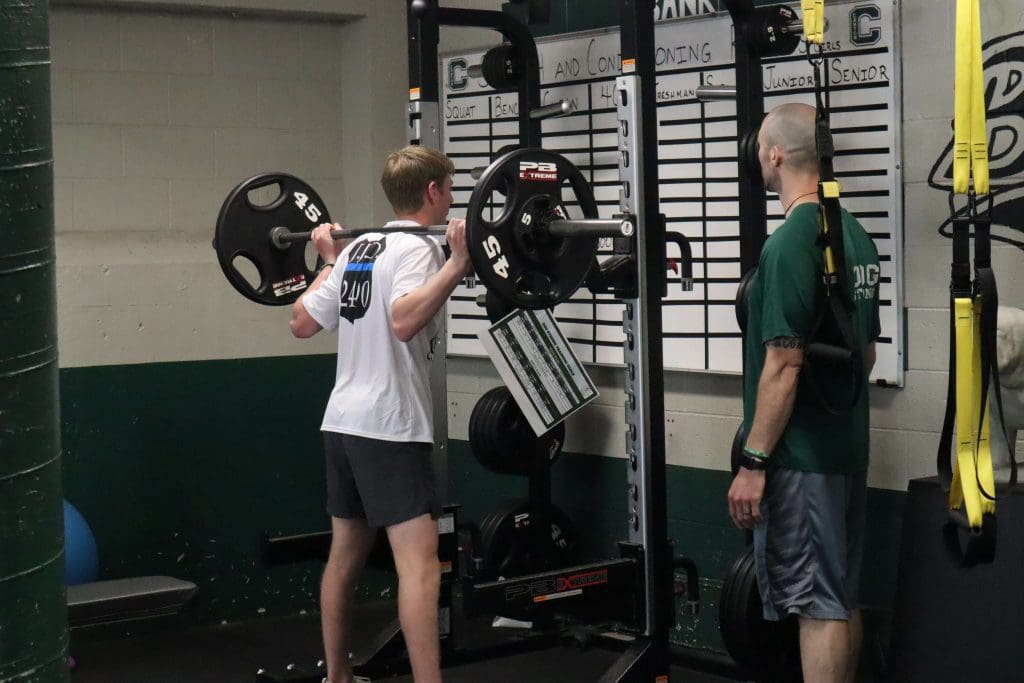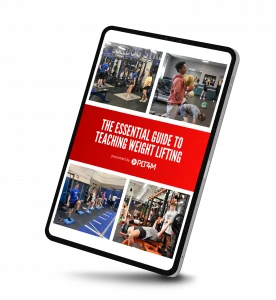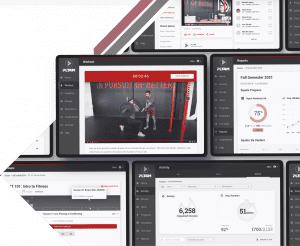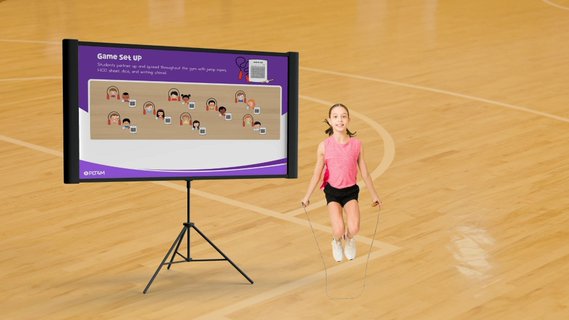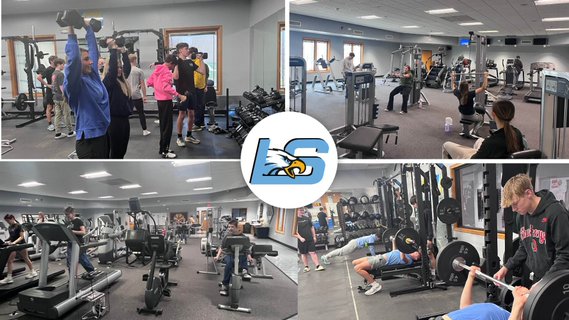Strength & conditioning classes are becoming a popular physical education offering. We take stories and insights from schools across the country to highlight 7 keys to successful strength and conditioning classes.
Defining Strength and Conditioning Classes
Before we dive into the 7 keys to successful high school strength and conditioning classes, let’s first get on the same page regarding what we mean by S&C class.
Schools across the country have a class centered around the weight room. In these classes, students seek to develop total strength, power, muscular endurance, and capacity, aka conditioning (aerobic, anaerobic, metabolic conditioning).
And while many of these classes have similar core principles, they often are labeled differently:
Strength & Conditioning Classes
Weight Lifting Classes
Strength Training Classes
Athletic PE Classes
Resistance Training Classes
Sports Performance Classes
For this article, we will call any of the above names strength and conditioning classes for the sake of consistency. However, no matter what you call your class, the following 7 keys to success can help to take your program to the next level

7 Keys To Successful Strength and Conditioning Classes
Every school is different. But over the years, we have connected with physical education teachers, strength coaches, sports coaches, and administrators and see consistent themes. We have pulled 7 keys to success from these themes.
1) Schedule and prioritize strength and conditioning classes
2) Make the class accessible to everyone
3) Set a strong foundation to build on
4) Personalize and individualize workouts
5) Inspire and motivate students with data
6) Encourage friendly competition with leaderboards
7) Utilize technology in your S&C classes
With these 7 keys, we will spotlight 7 schools across the country. Check out their full stories to learn more!
FREE E-BOOK
Essential Guide to Teaching Weight Training
Packed full of resources, videos, and real-life examples, this guide to teaching weight training will give you the blueprint to launch or improve your weights classes.
1) Schedule and Prioritize Strength and Conditioning Classes
Often high school strength and conditioning is done before and after school. However, due to busy schedules, transportation challenges, and other external factors, weight lifting before or after school isn’t feasible for many students. As a result, many students are not able to reap the benefits of strength training.
Strength and conditioning classes should be a part of the school day!
Justin Sherrod, a physical education teacher and strength coach at Wayland Union High School in Michigan, sees the power of classes during the day,
“We ask our students to do a lot. They have school, practices, games, jobs, and families. But, on top of all that, we also want them to lift. By structuring workouts into the school day through physical education, we free up our students’ time to let them still be kids.”
After working with the athletic department, guidance office, and other school members, Wayland Union went from 100 students to over 300 in the weight room throughout the day. By making it a part of the school day schedule, more students can make strength and conditioning classes part of their fitness journey.
2) Make The Class Accessible To Everyone
Historically, the high school weight room has been dominated by male athletes, mainly football players. But the benefits of strength and conditioning are not limited to the football field. All students, male and female, athlete and non-athlete, can reap the benefits of a strength and conditioning program.
Strength and conditioning classes should be accessible to everyone!
Rich Hargitt, a high school football coach and PE teacher at Emmett High School in Idaho, saw the weight room being dominated by his football team. He set out to change the culture of the weight room so that more female students wanted to take the strength & conditioning classes,
“Our main goal as educators is to promote healthy and happy lifestyles. This class provides opportunities for each and every student to embrace the various aspects of that life.”
Now, Hargitt is proud to see more female students taking part in the class and taking advantage of the high-energy workouts that he runs during physical education class.
3) Set A Strong Foundation To Build On
Many high school students have no previous experience in the weight room. And while many will be eager to jump right to the barbell and add weight, they need to build a strong foundation first.
Strength and conditioning classes should start beginner students with bodyweight movements. From there, they can follow a progression to build up to a comprehensive strength and conditioning program.
Aaron Schmidt, a PE teacher at Evergreen High School in Ohio, took a PLT4M curriculum map and onboarded every student through an introduction to fitness and strength training protocol,
“The curriculum map broke everything down and gave a clear structure of lesson plans to go from bodyweight exercises to students safely and effectively completing barbell and dumbbell workouts. Better yet, it was designed for all students, not just for athletes.”
Once students arrived at the more advanced strength and conditioning programs, Aaron saw students with great technique and form. Beyond just improved functional movement mechanics, students’ confidence helped make future weight lifting classes engaging.
4) Personalize and Individualize Workouts
Once students have set a strong foundation, they are ready to increase strength and success in the weight room. But it is important to remember that each student has different skills and abilities.
Strength and conditioning classes should personalize weights and workouts for students.
Andrew Shaw, strength and conditioning coach at Nashville Christian, has students with varying fitness levels in one class. Andrew knew personalization was the only way to help every student succeed,
“Because our strength and conditioning class is an elective, we have 8th-12th graders all in one class period. So as you can imagine, we have students and athletes with a WIDE range of experiences, strengths, and abilities. I wanted to personalize the training and workout experience for my student-athletes given their diverse needs.”
At Nashville Christian, every student completes a workout unique to their goals and experiences. For example, a freshman soccer player and a varsity football player might both be doing the barbell back squat, but their weights are unique and individualized to their strength and experience.
5) Inspire and Motivate Students With Data
The work students are doing in strength and conditioning classes needs context! Without context, class becomes just another 60 minutes of the day they have to be in school.
Strength and conditioning classes should inspire students with data and insights. Because these classes and workouts center around numbers, students can set fitness goals to keep them motivated and engaged.
Rusty Fuller, PE teacher and football coach at St. Paul High School in Nebraska, uses data throughout the entire school year,
“At the beginning of the year, we help students to take their baseline numbers and set goals that they can work towards throughout the year. The numbers don’t lie, and both our male and female students have seen tremendous growth that is exciting to highlight.”
At St. Paul High School, every student sees individual progress and results. Whether a student just started adding weight to the bar or is loading up the bar with multiple plates, individualized data can show both students the progress they are making. Individualized data can show every student their improvement and inspire future goals.
6) Encourage Friendly Competition With Leaderboards
While individual progress and improvement are excellent tools for intrinsic motivation, many student-athletes thrive with extrinsic motivation. A little friendly competition in the weight room can go a long way!
Strength and conditioning classes can incorporate leaderboards to encourage friendly competition.
Judd Hunter, PE department chair and strength coach at Arlington High School in Washington, says leaderboards have become a staple of their advanced S&C classes,
“The students taking the class are naturally competitive because they play and love sports. So it has become a fun way to motivate kids and promote friendly competition.”
Like many schools, Arlington has moved away from just using the traditional squat, bench, and clean leaderboard. Now, leaderboards highlight speed and agility metrics, pound-for-pound leaderboards, and other ways to showcase different students’ strengths and abilities.
7) Utilize Technology In Your Strength and Conditioning Classes
With all of the keys to successful strength and conditioning come the obvious challenges. Big class sizes, varying abilities and experiences, and loads of data can create a logistical nightmare for a PE teacher or strength coach.
Don’t try to do it all alone! Instead, utilize technology in your strength & conditioning classes to maximize efficiency and save time in your daily life.
Kurt Foster, strength coach and PE teacher at John Glenn High School in Indiana, transitioned from pen and paper to technology and isn’t looking back,
“It has saved me countless hours. With technology, I can get everyone the right workouts, track progress, and highlight improvements without toiling over excel spreadsheets all day long.”
At John Glenn High School, every student can access workouts on a 1-to-1 device or cell phone. As a result, Kurt can spend more time focusing on what matters – the students in his strength and conditioning classes.
Key Takeaways on Successful Strength and Conditioning Classes
All across the country, high schools are making strength and conditioning classes a staple of their school. While each school will take a slightly different approach, these common themes and tips can help take your classes to the next level.
It can be helpful to know your goals and set out from there. For example, do you want more students in the class? Are you hoping to get your current students more engaged? Do you want to improve the performance of your student-athletes on the field? Whatever your goal, take small steps to achieve your goals.
As you set out to grow your program, remember that Rome wasn’t built in a day. Start with just one or a few keys to successful strength & conditioning classes and grow from there. Before you know it, your strength and conditioning classes will be a well-oiled machine.
Not sure where to start? Contact PLT4M and schedule a free consultation with a strength and conditioning specialist. We are proud to partner with over 1,000 schools across the country to help improve all aspects of strength and conditioning, physical education, and athletics.
Ready to Learn More?
Schedule a free 10 minute consultation to see how the PLT4M system can help save you time, and empower student learning!
